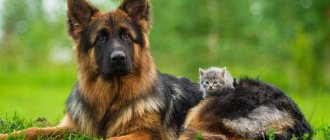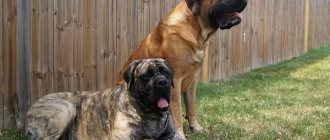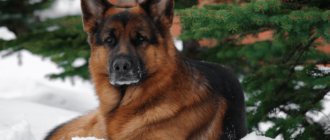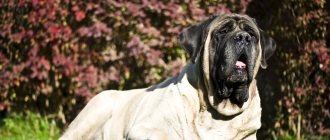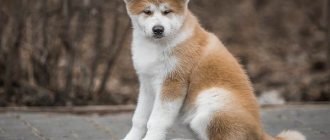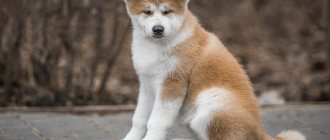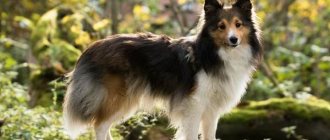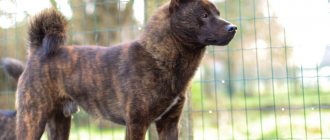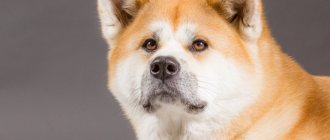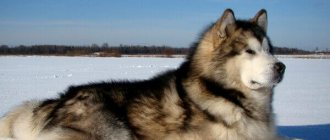| Breed name: | Alaskan Malamute |
| Breed name in English: | Alaskan malamute |
| Country of origin: | Alaska (USA) |
| Type: | Large dog |
| Weight: | 35-56 kilograms |
| Height (height at withers): | 58-71 centimeters |
| Color | White, black, blue, grey, agouti and combinations |
| Wool length | Average |
| Lifespan: | 10-12 years |
| Character | Active, playful, loyal |
| Number of puppies (average): | 5-8 |
| Price of puppies: | 600-2000$ |
Appearance
— Advertising —
The size of an adult dog can vary, but, on average, the height at the withers of males is 64-71 centimeters, females - 58-66 centimeters.
Average weight: 35-56 kilograms.
The description of the Alaskan Malamute should begin with the fact that it is quite a powerful animal. Dogs have large, wide heads and a large muzzle, which is equal to the width of their skulls. They have medium-sized almond-shaped brown eyes. The breed standards state that individuals with lighter coloration have lighter eyes.
— Advertising —
Pets' ears are small and triangular in shape, with slightly rounded tips. They are widely spaced on the pet's head. Malamutes have a huge upper jaw and a strong lower jaw with a scissor bite.
The dogs' body is powerful, muscular, and their back is straight. The dogs' fore and hind limbs are well developed and very strong. The animals' tails are covered with thick hair, set high and slightly curved upward. When at rest, these dogs hold their tails down. Dogs lift their tail up when they are petted or excited.
The Malamute has a thick coat, but it is soft to the touch. They have a dense, oily undercoat, 2.5 to 5 centimeters thick. It provides protection for animals from external threats. The coat and undercoat can vary in length and density. For example, the thickness around the shoulders and neck is greater.
This dog boasts a variety of colors. Color varies among the following shades:
- Agouti and white.
- Black and white.
- Blue and white.
- Gray and white.
- Sable and white.
- Silver and white.
- White.
- Red and white.
The breed always has white on the lower parts of the body, on various parts of the legs and on the face. This coloring on the face looks like a mask or a cap. Dogs may also have a white spot on their forehead and a white stripe in the form of a collar. The most characteristic color of the Alaskan Malamute is black body color. It helps the dog avoid ultraviolet exposure to the sun in the north.
The following lines of Alaskan Malamutes are distinguished:
- Kotzebue Line. The dogs are relatively short in stature and gray in color. It is believed to be a cross between a husky, a husky and an Alaskan malamute.
- Line M´Lut. This line is distinguished by its taller growth and different colors.
Regional varieties of the breed are also distinguished. For example, Siberian, Japanese, Canadian, Chinese and others. Photos are presented below.
Types of colors
The options for Malamute coat colors are amazing in their diversity. Basically, this is a combination of white and other shades, making each individual individual.
The monochromatic coat color of representatives of this breed can only be white .
Black and white
The awn is black, the undercoat is black or dark gray. The Seal and White color can also be included in this category - in such dogs the guard hairs are completely black or only at the tips, and the undercoat is white or cream-colored.
Puppies of these colors have almost the same color at birth; it is almost impossible to predict what the adult will be like.
Gray with white
The guard hairs are gray, and the undercoat is white, cream or light gray. Any inclusions of a reddish tint are unacceptable.
Although there may be darker or black hairs along the topline, Malamutes with this coloration give the impression of a gray dog.
Sable with white
The awn is black or gray, the undercoat has a reddish tint. Visually, shades of both black and red are clearly visible.
Silver with white
In such dogs, the guard hair is pigmented with a light gray color, and the undercoat is white.
Gray-white, silver-white and sable-white colors can be classified as one color group, which most people mistakenly consider to be the only correct one for this breed.
Red with white
The awn is colored in any shade of red: from rich brown to golden yellow. Black color is not acceptable.
Blue and white
Blue color is formed as a result of genetic dilution of black. Blue and white Malamutes have blue rings on the guard hairs, and the undercoat is dark gray or blue.
Solid white
These Malamutes have a snow-white coat and the same undercoat. Some individuals have a less pronounced creamy mask. They can only be born as a result of the mating of two white individuals.
Pros and cons of a dog
Pros:
- They are funny and cheerful.
- The dogs are very smart and learn quickly.
- Pets are good for children of all ages.
- Animals have a good sense of humor, although sometimes they are mischievous.
- This breed is an ideal choice for people who lead an active outdoor life and love dog sports.
Minuses:
- Dogs shed a lot, especially in spring and autumn.
- Animals can be very stubborn.
- A special feature is that pets love to dig large holes.
- They are not the best choice for first-time dog owners.
- Malamute puppies are expensive. Their maintenance will also cost you a lot.
- Dogs need constant exercise, both physically and mentally.
- They need a lot of care and attention. The dog suffers from separation anxiety if left alone for a long time.
Read reviews about a pet online before bringing it into your home.
How to measure height correctly?
To correctly measure growth, it is necessary to place a puppy or an adult Malamute in a show stand or somehow attract his attention so that the pet can stand for several minutes without moving.
It is most convenient to use an assistant for this purpose, who will distract the animal during measurements by showing it a treat or an interesting toy.
It is also very important that the dog stands on a flat and hard surface during this procedure, for example, on the floor or asphalt.
The Malamute's height should be measured using a measuring tape or a long ruler equipped with a freely moving stop..
To find out the height of the pet at the withers, the edge of the centimeter with the smallest division values is applied to the withers, and the opposite side of the tape is evenly stretched to the floor, after which a mark is made on it in the required place.
If height is measured with a ruler, then its edge is placed on the floor, after which the limiter rises up to the level of the withers.
Considering that the Malamute’s coat is quite long and thick, in order to avoid errors when measuring, it is recommended to spread it out before applying a centimeter tape or a device for measuring height to the withers .
History of the breed
Like most Spitz dogs, the Alaskan Malamute evolved in arctic regions. The origin of the breed is not known with certainty. They lived near Norton Sound on the northwest coast of Alaska. The word "Mahlemut" comes from "Mahle" - the name of the Inuit tribe, and "mut" means village. These animals were used by the native people of northwestern Alaska to haul heavy sleds to hunt seals and polar bears. The dogs also served as bait.
With the discovery of gold in 1896, foreigners began to come to Alaska. To amuse themselves, they organized races among their dogs. They also crossed breeds of local dogs in the hope of breeding the fastest individual. The pure Malamute was in danger of extinction.
However, in the 1920s, a greyhound racing enthusiast from England obtained several purebred dogs. After this, he began breeding traditional Malamutes. The breed's reputation grew. Some of the individuals were chosen to assist Admiral Byrd on his 1933 expedition to the South Pole. During World War II, dogs were used to transport goods and animals.
In 1935, the breed received recognition from the American Kennel Club.
History of the origin of the Alaskan Malamute
The Alaskan Dog is the oldest representative of the indigenous dog breeds in North America. As archaeological excavations confirm, the Malamute is one of the first dogs domesticated by humans. Perhaps today's northern giants are descendants of once domesticated wolves.
When looking at these dogs, there really is a resemblance to wolves, which was proven by scientific research conducted in 2004.
The descendants of wolves came to Alaska thanks to their owners, who swam across the Bering Strait about 14 thousand years ago. The main purpose of the Alaskans was to transport heavy cargo in harsh Arctic conditions.
In ancient times, northern giants helped their nomadic owners hunt and also guarded their homes. Life in the far north played a huge role in the development of dogs as a breed. The constant lack of food, harsh living conditions, hopeless cold - all this contributed to the preservation of only those representatives who turned out to be stronger and more resilient than the rest.
At the end of the twentieth century, Alaskan Malamutes won the hearts of Europeans who came to Alaska under the influence of the gold rush. Streams of foreigners wanting to get rich from gold mining kept coming. And every European was interested in acquiring a convenient and reliable means of transportation on the ground.
Alaskans were the only animals that were able to withstand the harsh conditions of the north. They provided assistance in moving cargo and transporting people. The increased demand for these dogs contributed to an increase in their prices. By today's standards in dollars, then they paid for them from 13,000 for one unit and up to 40,000 for one team. Alaskans were in high demand among gold miners, despite the high price.
In an effort to obtain an even more hardy breed, Europeans tried to cross local Malamutes with Newfoundlands and St. Bernards brought specifically for this purpose. The breeders did not get the expected results, because the resulting offspring turned out to be unable to work as a team.
At the beginning of the last century, dog sled racing gained popularity in America. The sport gained historical fame in 1908 with a 408-mile race called the All Alaska Sweepstakes. Dogs from all over Alaska participated, and for the winning owners, this meant receiving monetary rewards and recognition.
But! Malamutes proved unsuitable for racing because they were not as fast as other competing dogs. Because of this, they tried to crossbreed Malamutes with representatives of small breeds. Attempts led to the threat of extinction of Alaskans as a species. In 1920, the number of these dogs reached a critical minimum. Only thanks to a team of enthusiastic breeders, consisting of several people, was it possible to preserve the breed.
The Second World War also caused great damage to the number of purebred dogs. The participation of four-legged helpers in hostilities almost led to the complete disappearance of the breed. In 1947, when there were only 30 Malamutes, through selection it was possible to restore the breed of Arctic beauties.
Today, Alaskans are considered a popular and famous dog breed. Many northerners will be happy to purchase such a pet. Adapted for centuries to hard work, dogs still perform their basic functions despite the fact that they have come to be considered the official symbol of the American state of Alaska.
Maintenance and care
To keep your pet healthy, you need to remember a few rules: carefully monitor its diet, exercise, and regularly brush its teeth and coat. Also, be sure to stick to your veterinarian's schedule for vaccinations and checkups.
- Walk your dog for at least an hour a day. Daily activity helps dogs avoid boredom, which leads to destructive behavior. Going outside will eliminate most of your pet's instinctual urges: chewing, digging, chasing.
- Make sure everyone in your family spends plenty of time with your pet.
- Feed the animals food that contains a mixture of different amino acids. Dogs may suffer from zinc deficiency. Sometimes animals need more of an element than a balanced dog food contains.
- Alaskan Malamutes were bred to be working dogs in cold environments. As a result, they have thick coats that require intensive grooming. Brush your dog thoroughly at least twice a week. Occasionally trim the long fur around your pet's feet and nails.
- Bathing the animal is optional. This may be necessary if the fur gets stuck together. When bathing, use dog shampoo and warm water. Don't let your pet go outside in cold weather until his fur is completely dry.
- Your pet needs a warm, calm place to rest. The dog doesn't like drafts. You might consider buying a pet bed or making one out of a wooden box. Lay down a blanket or pillow for softness.
Training and education
Malamutes are very smart and agile, and these qualities appear almost from birth. A puppy of this breed begins to strive for leadership early. In his upbringing, one must show firmness and consistency, constantly give feasible physical activity, which should be increased as he grows older. You can start training immediately after purchasing a puppy, teaching him how to call, simple commands and, what is also important, how to be neat.
Steel endurance
It is important to know: innate good nature does not prevent dogs of this breed from being aggressive towards other dogs or chasing cats or birds.
Socialization of a Malamute is an important stage in his life. You can start visiting the training site from the age of 4 months, when the vaccination quarantine ends. In addition to teaching discipline, a Malamute puppy, communicating with other dogs, will certainly find friends for noisy games. At the same time, you should accustom your pet to extraneous sounds, passing cars and other irritants. Thus, you will strengthen his nervous system and make the dog’s living in the city comfortable. Many owners who plan to place a dog in a country house sometimes neglect these simple rules. As a result, the dog's socialization suffers; it feels uncomfortable on noisy city streets.
Nutrition
Alaskan Malamutes are large dogs, so feeding their pets will not be cheap. Dogs love to eat, but are not picky eaters. Therefore, they will eat everything you offer them. Give your pets high-quality food. Bad food can lead to the development of deficiencies of minerals, vitamins and other valuable substances. Feed them once or twice a day.
An adult Malamute should eat the following amounts of food per day depending on the animal's activity:
- With a weight of 38 kg – 366-482 g.
- With a weight of 40 kg – 381-501 g.
- With a weight of 45 kg – 409-538 g.
- With a weight of 50 kg – 437-575 g.
- With a weight of 56 kg – 465-612 g.
Possible diseases and methods of treating them
Malamutes are strong and healthy dogs that tolerate cold well. Unfortunately, the useful insulating “coat” of thick, long fur becomes their curse in the summer. At high temperatures, the animal experiences difficulty breathing. This may even cause you to faint.
If you notice that your furry pet's health has worsened during the heat, we recommend giving him a cool bath. This will help stabilize the condition and reduce his body temperature. Some huskies suffer from hip dysplasia. In this case, veterinarians prescribe medications for them, including painkillers, which owners can administer on their own.
And lastly, dogs with thick and long fur often get fleas. These unpleasant parasites cause a lot of trouble not only for animals, but also for their owners. Therefore, you should treat your Malamute's coat several times a year with a special flea medicine. This also helps prevent them from occurring in the future.
Breeding
In female Malamutes, the first heat occurs at 8-12 months. Then it is repeated every six months. Its duration ranges from 18 to 20 days. At this time, the animal may become disobedient, excitable, and refuse food.
Before breeding dogs, you need to pay attention to the following. Decide what color you want offspring, based on this and select a pair. To avoid incest, analyze the previous 3 generations by pedigree.
Pregnancy of bitches lasts 59-63 days. About 9-10 hours before giving birth, your dog will begin to behave restlessly, this is due to the start of pushing. As a result of childbirth, 5-8 babies appear.
To what age do they grow?
Like other large breeds of dogs, Malamutes grow in height until about 1.5 years, later they gain muscle mass and weight for several more months.
Moreover, the most intensive growth occurs in the first six months of a puppy’s life.
NOTE!
The onset of heat in a female dog can significantly reduce the rate of growth and weight gain.
In general, it is believed that a malamute grows in width up to two years and after this age, the dog is considered to be fully grown.
Puppies
When purchasing a baby, you must understand how vulnerable he is in the first months of life. Here are some dangers a puppy may face at 6-8 weeks:
- Plants.
- Water.
- Electrical cords.
- Poisonous products and substances.
- Predator birds.
You should make sure to purchase the right toys for your baby. Why is it necessary? Otherwise, he will chew your things. Do not give him clothes or shoes as toys, as the puppy will use them regularly in the future. Make sure the toys have the appropriate texture and size.
Place an ID collar on your pet. If your pet gets lost, it will be returned to you immediately.
Many dog breeders don’t know what to feed their little friend. It is important for the baby to follow a diet. Otherwise, he may have an upset stomach. Breeders usually give new owners a feeding schedule for their puppies.
Approximate amount of food for babies, depending on body size:
- 2 months – 298-329 g.
- 3 months – 386-417 g.
- 4 months – 425-456 g.
- 5 months – 495-526 g.
- 6 months – 557-558 g.
- 7 months – 559-590 g.
- 8 months – 524-555 g.
- 9 months – 491-526 g.
- 10 months – 458-489 g.
- 11 months – 429-460 g.
- 12 months – 402-433 g.
- 13 months – 399-430 g.
- 14 months – 395-426 g.
Babies aged eight to twelve weeks need four meals a day. From 3 to 6 months of age, feed them 3 times a day. From 6 months to a year – 2 times a day. Photos of the puppies are presented below.
Socialization
Alaskan Malamute puppies are smart and intelligent. For proper development, you should alternate mental and physical exercises. Without regular exercise, they develop “bad habits”: howling, whining, digging, chewing objects. To avoid problems, socialization begins as early as possible.
Alaskan Malamutes combine good nature towards people and a desire to dominate. They should not be owned by novice dog owners. Before raising an animal, you should carefully study the characteristics of its temperament.
Until the age of 3, dogs are actively trying to take a leading position, so the correct hierarchy needs to be built at an early age. Only an experienced person can handle this task.
Raising a Malamute is not an easy task. Animals learn easily and quickly understand how life works in a human “flock.” Therefore, questions about how to train a puppy to use the toilet outside or teach him the simplest commands usually do not arise. However, not everything is so smooth.
Pets are capable of being incredibly stubborn if they do not consider the owner to be the leader. Training an Alaskan Malamute requires patience. Day after day he will have to prove that the owner is the undisputed leader. It is strictly forbidden to scream and use physical force, otherwise the person will lose authority in his eyes.
If the owner cannot overcome the dog’s stubbornness, it is better to entrust the puppy’s upbringing to an experienced dog handler.
In relation to small domestic animals, animals demonstrate a hunting instinct. Aggression towards dogs of the same sex is possible if the Malamute puppy is not introduced into the community of relatives in time.
Animals and children get along well. The dog will happily pull the sled, play catch, and fetch the ball. But it is better not to leave him with children without adult supervision. He may accidentally push or scare the child.
Dog character
Although these individuals look large and impressive, they are extremely friendly in nature. It is unlikely that your dog will make a good house guard, since he rarely howls or barks.
Pets must be well socialized from childhood. Introduce them to a wide range of people, animals and situations early in their lives. They are not the best choice for those who are looking to get a dog for the first time. The Malamute must know its place in the “pack” and who is boss in the house. Therefore, you must initially become a leader for your pet.
Malamutes are excellent diggers and will happily dig a hole to escape from the garden. For this reason, many owners do not leave them outside unattended.
Dogs have a high level of hunting instinct. They will chase any animals that come into their sight.
By nature they are playful individuals. Some of them excel in many dog sporting activities.
Dogs are loyal to their owners. They hate being left alone. Dogs prefer to always be close to their owner. They are suitable for families where at least one person remains at home. Long separation from the owners leads to excessive activity and aggression of the dog.
Mini Malamutes – do they exist and what do they look like?
The dwarf malamute or “Alaskan Klee Kai” is an independent breed, the representatives of which, due to the mask on the face, look like a husky, but have a completely different character.
These dogs were bred from the mating of Alaskan Malamutes, Laikas and American Eskimo dogs.
Representatives of this breed, due to their calm nature and small size, do not require complex specific care or professional training skills. They tolerate frost well and are suitable for both outdoor and indoor use.
Alaskan Klee Kais grow up to be good friends and faithful companions of their owner, in addition, they become excellent nannies for children.
Education
Education, training and socialization of Alaskan Malamutes should begin as early as possible. They are smart and, with the right approach to training and education, learn new things well. However, dogs do not react too quickly to any commands. This must be taken into account when training them. Successful training requires time and patience. Pets will enjoy tasty rewards during exercise.
It is important for these dogs to know their place in the “pack” and who the “alpha dog” is. Otherwise, they take on this role themselves. Puppies need to be taught basic commands from childhood. For example, like this:
- Come.
- Sit.
- Stay.
- Quiet.
- Leave it.
- Place.
Reproduction and lifespan
An Alaskan Malamute that is well fed and cared for will live at least 14 years. The average lifespan of such a dog is 13 years. A professional breeder must be aware of the distinctive characteristics of huskies in order to select the correct male and female for breeding. So, for high-quality representatives of this breed:
- Triangular-shaped ears rounded at the edges.
- Curled tail.
- Brown iris.
- Strong legs.
- Long and hard fur.
It is desirable that the male and female are the same age. An important point is that there should be no blood relationship between them, otherwise the puppies will be born genetically defective. Malamutes are bred when the bitch is in heat, preferably on the 3rd day after its onset. It is better to organize the breeding of dogs on neutral territory.
Diseases
Fluffy Alaskan Malamutes suffer from certain inherited and acquired health problems. The most common are:
- Hip dysplasia.
- Visual impairment, including hereditary cataracts.
- Alaskan malamute polyneuropathy.
- Epilepsy.
- Gastric torsion/bloating.
- Chondrodysplasia (dwarfism).
- Alopecia X.
Dogs often suffer from a condition known as alopecia X. This is an inherited skin disorder. The condition goes by other names, including black skin disease or follicular dysplasia. The disease affects breeds with thick, dense double layers of coat.
This endocrine disorder may be due to dogs producing too much cortisol. Symptoms include the following:
- Excessive hair loss.
- The remaining hair appears brittle and dry, especially around the neck and tail.
- Bald patches appear on certain parts of the body, where the skin turns black.
Contact your veterinarian who can help you deal with this problem.
When a dog experiences seizures, the condition is referred to as having idiopathic epilepsy or generalized primary epilepsy. Research has shown that about 6% of dogs may suffer from this condition. This can be caused by heredity, as well as the following conditions:
- Brain tumors.
- Head injury.
- Low blood sugar or oxygen levels.
- Diseases or infections.
- An infectious or inflammatory disease of the nervous system.
- Toxins.
- Botulism.
- Parasites
- Low serum magnesium or calcium levels.
- Imbalance of sodium or potassium levels in the blood.
- Kidney failure.
- Hyperthermia.
- Deficiency of thyroid hormones.
Be sure to contact your veterinarian who can help you make the correct diagnosis.
Owner reviews
The Alaskan Malamute is a breed for those who want a strong and kind friend and companion. Although it should be noted that considerable experience is required in raising a dog of this breed. According to many inexperienced owners, the Alaskan Malamute is practically impossible to train, so such a dog cannot be called smart. According to experts, this dog is quite smart and is able to correctly assess the current situation.
In order for a Malamute to begin to learn and carry out all the necessary commands, the dog must have a certain motivation. Anyone who has worked with this dog knows how stubborn a Malamute can be.
In this case, a person must show purposefulness and perseverance, but only within reasonable limits. If you overdo it, a proud and wayward dog may become offended.
Many owners note that this dog is quite smart and kind, so it can easily become a true and devoted friend.
Nowadays you can find a sufficient number of breeds that are similar to this breed. Naturally, they do not meet breed standards, although they look quite attractive. It is better not to have such dogs, since they are associated with uncontrolled and disorderly crossing, which leads to disturbances in the functioning of the immune system and to a general deterioration in health. The most important thing is to always remember that a dog is not a toy, big or small, but a living creature to whom you need to give some of your affection, care and love.
Interesting Facts
- The Alaskan Malamute is a cargo dog. It is grown to transport heavy loads over long distances.
- The dog's power was used during the Klondike Gold Rush.
- Alaskan Malamutes do not have blue eyes. Their eyes range from light to dark brown and amber, depending on the color of their coat.
- These are the official state dogs of Alaska.
- Dogs were used in World War II to detect mines, carry weapons, and perform search and rescue duties.
- There is a giant malamute. The characteristic of the breed is that the weight of females and males is truly gigantic: 55-80 kilograms.
- Films in which you will see Malamutes: “White Captivity”, “Iron Will” and “The Last Trapper”.
Price
There are quite a lot of huskies in Russia, including the ones in question. Their prices vary. It depends on the dog’s pedigree, its health, parameters, city, etc. ex-hand price of an Alaskan Malamute
We recommend working with competent breeders who have a good reputation. There are nurseries in Russia where elite representatives of the breed are bred. They are born from famous champion dogs. The cost of such pets is from 20 to 30 thousand rubles.

